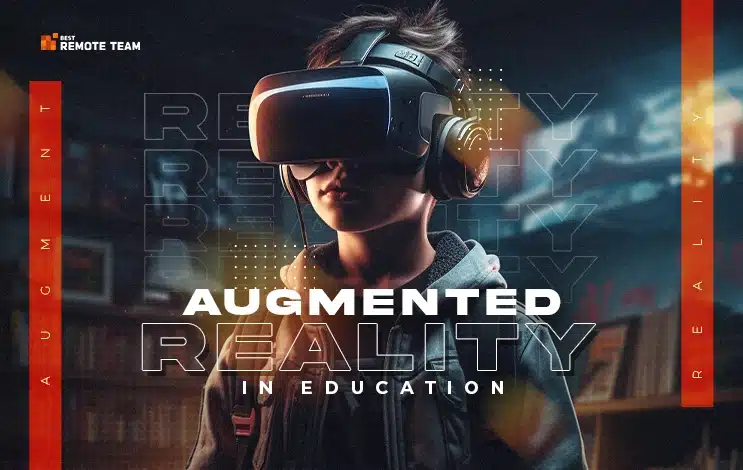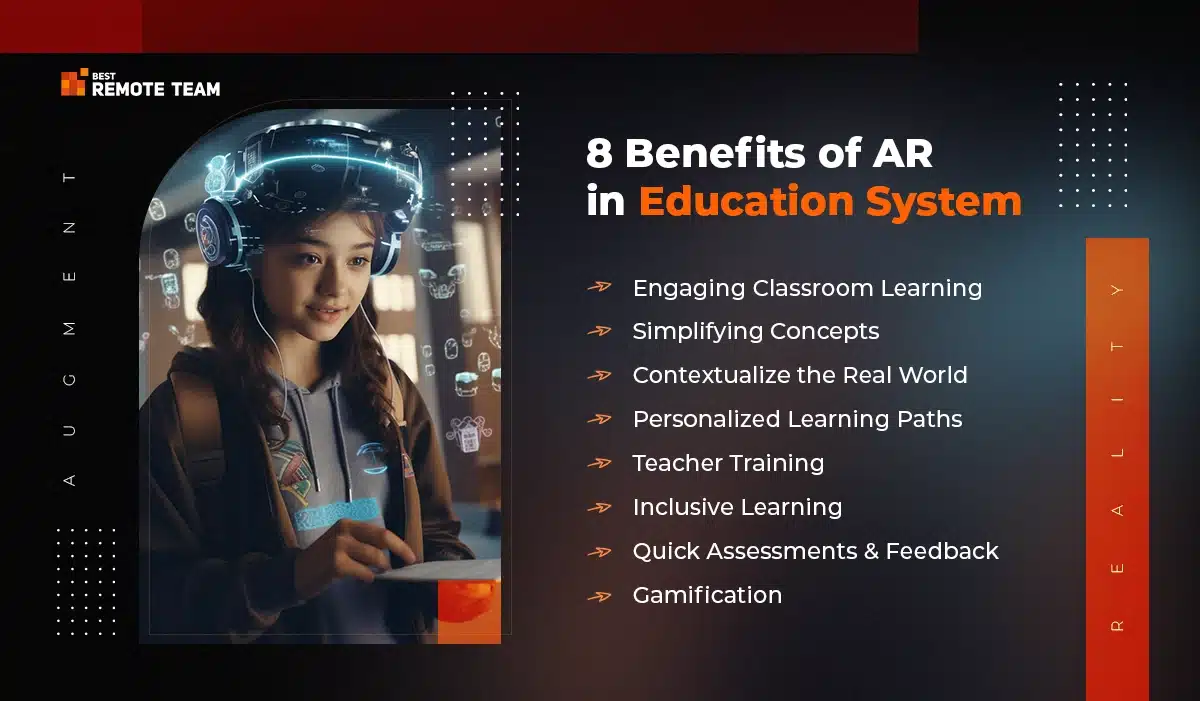Augmented Reality & Education: An Overview
Augmented Reality market size was estimated at $42.2 billion in 2022. It is expected to reach $1109.7 in 2030. More industries are adopting AR for training and monitoring purposes. This technology is likely to close the gaps that exist in the industry.
The rise in 5G technology will fuel the growth of Augmented Reality as it promises to reduce latency.
What is Augmented Reality?
Before we move further and understand why you must use AR in education, let’s understand this technology. What do you think of when you hear AR? If you are clueless about what this technology does, we will give you a brief overview.
Remember the game Pokémon Go? That’s the best way to explain how AR works. There were elements overlayed into the real world.
So, you were scanning virtual characters on real roads and inside real places. That’s what AR does. It doesn’t remove you from reality; it implements the virtual elements in the real world.
In simple words, digital information overlaps with the real world in the form of animations, videos, 3D models, and images. It doesn’t create an immersive experience that you get with Virtual Reality.
However, the users get a better understanding of the virtual elements and their use via this interaction.
For this purpose, the technology will use hardware including mobile devices or tablets, and wearable technology. They would place sensors and cameras around the object to create a 3D view. This can help aptly place the elements in the real world.
The users will learn more from these interactions and it will enhance their experiences.
How it can Benefit the Education System?
The education industry is transforming under the wings spread by technology. We will be looking at how one technology, Augmented Reality, can refine the whole industry.
#1 Engaging Classroom Learning
One of the biggest concerns for the education industry is classroom learning. Whether it is happening via live classes virtually or offline, there is a level of disengagement among the students.
Whether you are explaining the tough concepts or taking them through history, you will notice the students getting bored. AR experiences are an incredible way to make learning interesting. You can improve your storytelling abilities by overlaying digital elements into the real world.
Let’s say, you are talking about a historical moment. You can easily use the digital elements and make the whole aspect interesting. The students will get immersed in the story and will learn better in a smart classroom.
#2 Simplifying Concepts
Whether you are teaching science or Maths, there will be concepts that can be difficult to digest. Your students might face difficulty understanding the basis and how to use the concepts in real life.
Instead of explaining it the chalkboard way, you can use demonstrations and 3D objects to improve your concept explanation.
Each concept can be broken down into real-world demonstrations, thus ensuring a simple explanation. As things will occur via animations and 3D interventions, your student will get a complete understanding of the concept.
#3 Create a Real World Context
There are times when field trips can turn into boredom. There is not much to see there, and you don’t have a complete background of the things around you.
That’s what happens when you take your students to the museum or other places. They don’t understand, which is why they tend to learn less.
However, you can make the field of education interesting by allowing the students to interact with the elements using AR. You can create content using AR for each specimen on the field. Explain each monument and its importance with the digital overlay.
This would enhance the engagement in the field trip and turn it into an educational opportunity.
#4 Personalized Learning Paths
No two students learn the same way. You will notice that there are people who quickly grasp the things that have been introduced. On the other hand, some students may not comprehend what has been explained.
You need to ensure both have a learning solution that matches their pace and requirements. using AR, you can offer a more personalized and pace-driven learning solution. You can customize the content to meet the individual’s needs.
Moreover, you can offer them quizzes and materials that make them understand it better.
#5 Teacher Training
One of the key elements of the education industry is the teacher’s evolution and understanding. You will notice that the teachers should be equipped with a lot of tools and training to help the students.
Most often, the teachers are unaware of how to use basic technologies. They aren’t even up-to-date with the current trends. That’s why you need to ensure proper teacher training across verticals.
AR can enhance teacher training abilities at your institution. They can easily upskill themselves, learn new concepts, be clear about the current practices, and update themselves as individuals.
#6 Inclusive Learning
There are all kinds of students in a particular education system. You will find learning and physical disabilities around the corner. Your education system should cater to their needs and ensure they are learning.
Break down each concept for the student. Make sure you teach them in a way that establishes the norm for continuous learning.
That’s where AR technology can help. It will introduce the concepts in a more inclusive fashion offering various methods. It can enable inclusivity and engage all learner types.
#7 Quick Assessments and Feedback
One of the biggest concerns for the teachers is assessing their student’s abilities and then sharing the feedback. This can happen with greater ease and in real-time when you are using AR. You can use the elements to conduct the assessments and tests.
The simulated environment will help the student demonstrate the concept and help the teacher assess their abilities better. In case of any issues, the teacher can showcase the concept in the real world again.
#8 Gamification
Gamified AR applications are winning the hearts of several students and teachers. It allows the teachers to create interesting challenges and engage the students better. With rewards and multiple levels, the students can demonstrate their learning more effectively.
Read More: A Definitive Guide to Creating Interactive Learning Apps with Flutter
AR Use Cases in Education
By leveraging Augmented Reality, you can offer innovative ways to enhance the classroom and virtual learning experience.
#1 Interactive Textbooks
There is a limitation to the information that your textbooks can offer. Moreover, the print can make learning uninteresting. With AR, your students can scan the texts and gain a more in-depth view of the topic.
They will be drawn into the world of 3D models, animations, and quizzes that will help them articulate the subject better. Incorporating virtual reality into learning can help you build a robust classroom.
#2 Maths & Geometry
Several equations in Maths don’t make complete sense. In many cases, they are abstract concepts, and explaining them can be difficult. With AR, teachers can easily demonstrate these equations using the 3D models. They can always tell the students how the equation is solved, making it easier for the kids to grasp.
Similarly, with geometry, your teachers can easily use interactive shapes and spaces to explain the equations. This would take the whole understanding of equations to the next best level.
#3 Virtual Labs
If a child is being schooled via online resources, helping them complete experiments or lab work can be challenging. Augmented Reality technology removes the challenges related to experiments. Your students can easily access the virtual labs via AR. They can work on the experiments using the equipment and materials within the digital world.
This entire experience would occur in a controlled environment, thus enabling better experiment results.
#4 Learning Maps
Understanding maps is difficult if you are only learning everything theoretically. AR allows your students to create maps, explore geographical features via overlays, and simulate the entire geography.
It is a way forward towards experiential learning and allows your children to understand maps better. It will also help them build a strong foundation in geography.
#5 Collaborative Learning
Whether they are working on a project or wish to collaborate on the concept, AR gives better collaboration opportunities. You will notice that the technology allows the kids to share their projects in a more controlled and engaging environment.
The students can easily take note of each other’s tasks. They can also make the changes in real time, and ensure a working model. They can also participate in several activities that move beyond classrooms with the collaborative learning model.
#6 Understanding the Astronomical World
While this is not an abstract world, it is not entirely visible to the naked eye. This can lead to several issues when explaining how they work and what happens in the celestial world. To avoid the learning challenges, you can engage AR systems.
It will help demonstrate the celestial world to your students, and give them a better understanding of how they move around. Once they view these concepts in the real world environment, it becomes easier for them to understand and imagine the spaces.
#7 Art and Design
Interior design or architecture students will benefit from AR in education. Most of their work is done in real-world settings. However, not being able to perceive the actual settings can make things difficult.
AR allows them to demonstrate the real-world setting and understand how a particular design or architectural work will appear. It will help them move forth with the plans.
People also read: Top 5 Augmented And Virtual Reality Development Companies
The Challenges and Ethical Considerations for AR
The AR ecosystem is still not fully established within the education industry because of the challenges it poses. Let’s look at a few challenges and how it is a roadblock.
#1 Infrastructure and Accessibility
There are two parts to accessibility- the devices and the Internet connection. Without this infrastructure, you may not be able to achieve the desired AR outcomes. However, there is a cost involved in setting up the devices for the students, especially in schools. Similarly, having a stable internet connection may be a challenge in certain places.
#2 Privacy & Security
When you are using it in the educational system, you might want the data to remain private and secure. There is a lot of student data that you are working with. Compromising that might cause more trouble.
You can overcome this issue by incorporating the privacy policies and compliances. Similarly, you can also include informed consent. In this case, the student will consent to data collection and usage in a specific manner.
#3 Quality of Content
It is important to note that if the content quality is not good, it may not engage the students. That is the first aspect that you must work on. It is possible that the information is not accurate or completely presented.
In some cases, AR might not place all the necessary information, making it incomplete. Similarly, if the content is not adding value, it may not be quality content for the users.
#4 Teacher Training
Educators aren’t well-versed with the technology. This can cause issues when implementing AR tech in the education industry. You might need to ensure that the teachers are trained and understand how to use the technology before they impart knowledge.
#5 Ethical Considerations
There are two portions to this aspect- accessibility to infrastructure and screen time.
There will be a divide between the people who can access the infrastructure and those who cannot. It will widen the learning gap further. At the same time, screen time will go excessive as you are resorting to digital education. This can also cause further issues.
Future Trends & Considerations
Let’s look at the future of this technology, and how it will impact the course of adoption.
#1 5G Technology
This future technology will pave the way for more AR solutions in the education industry. It promises to reduce latency and speed up data transfers. Moreover, it will enable better and more engaging AR solutions. As a result, this tech may further AR in education.
#2 Personalization
One will notice a steep growth in this trend as it can impact learning positively. As AR collects more data regarding study habits and content requirements, it can create a more adaptive learning solution.
#3 Cross-reality Paths
AR can collaborate with VR and MR to create more immersive content for the education industry. It will expand the learning experiences and enhance the diversification within the industry. You will notice better learning paths and engaging content with the collaboration of these three realities.
#4 Augmented Assessments
Teachers can easily introduce newer assessment methods and techniques that would establish their abilities. The students can use projects and simulations to showcase their learning and make the assessment easy and fast.
#5 AR Authoring Tools
More AR authoring tools will be introduced in the education industry. This will enable educators to create AR content for their kids without the technical background. They can also enable better AR-based education solutions for their classes.
#6 Student-centric Design
The future AR apps will consider the student’s learning needs and curve to create the design and structure. With these apps centered around learning, it can foster better engagement and improve the learning experiences.
AR Apps for Kids
Here are some interesting and educational AR apps for your kids.
#1 Quiver
This is a 3D coloring app that engages your kids easily. You must download the coloring sheets and print them from the site. Color these sheets, scan the sheet using the AR app, and see how your simple drawing turns into a 3D model.
#2 Skyview Lite
If your child wants to learn about planets and stars, this is the right application of AR. You can easily point at the sky or towards a particular spot. You can scan the objects there and learn about them in detail via application
#3 Animal Safari
You will get 3D models of wild animals in the real world with this application. You will get to see more realistic features and sounds of the animals. A great way to teach the students how each animal appears and their distinctive features.
#4 Photomath
This is a unique application that allows AR to help with concept maths. Your child will get a greater understanding of the solutions to their textbook math problems. With visualization and 3D models, this application will explain how to work on a particular math concept.
Conclusion
Augmented Reality can redefine the education industry with more engaging and inclusive content. It can help with better demonstrations, improve conceptual clarity, and enhance learning abilities.
Students will gain a more in-depth understanding of the theories and can perceive them better. Educators will find a better way to explain the theories and enhance the learning environment. As the use of AR will pace up, you will notice better content and app varieties for the students.
If you want to enhance the student’s learning, you must engage in AR solutions. Having a good app idea is not enough. You need a supportive development environment and partner to help you build the idea.
Best Remote Team can help identify the best AR development partners for your business needs. Connect with us to hire developers using flexible engagement models.







